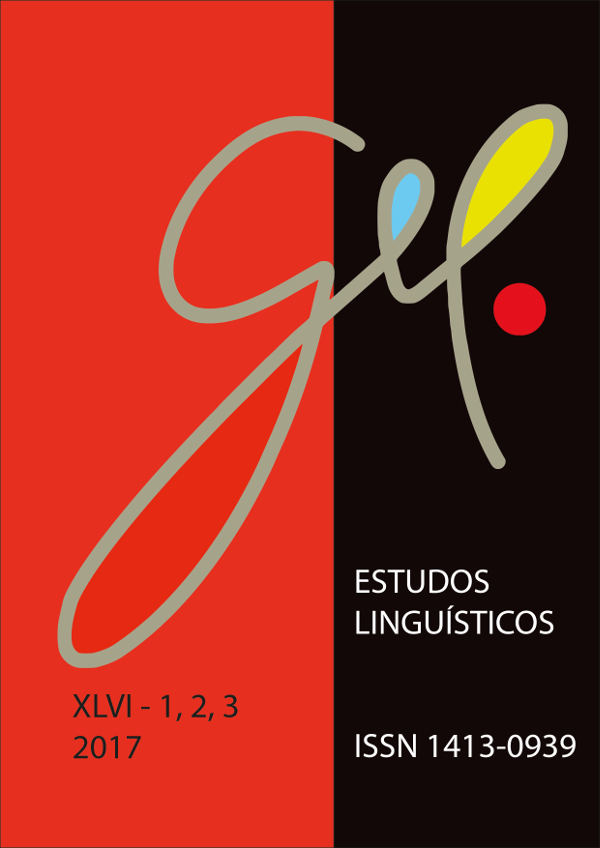“O rouge virou blush”. Será, Veríssimo? O que nos dizem os dados do Atlas Linguístico do Brasil/Centro-Oeste
DOI:
https://doi.org/10.21165/el.v46i1.1756Parole chiave:
norma linguística, centro-oeste, rouge, Projeto ALiBAbstract
Tendo por base a teoria do Relativismo Linguístico Sapir-Whorf, entendemos a língua como objeto social, meio pelo qual os homens, além de transmitir crenças, hábitos e conhecimentos, também compreendem sua realidade e mesmo a transformam. Nesse sentido, este estudo discute traços da realidade linguística do Centro-Oeste a partir dos nomes para rouge/blush proferidos pelos informantes do Projeto Atlas Linguístico do Brasil entrevistados em 21 localidades do interior e também nas três capitais de Estados dessa região, tendo por base o aporte teórico da Lexicologia, da Dialetologia e da Geolinguística. Como objetivos do trabalho, busca-se compreender como a realidade linguística pode revelar características como relações sociais e aspectos sócio-histórico-econômicos da comunidade em questão, além de se ratificar a importância dos estudos lexicais para o (re)conhecimento de realidades linguísticas em determinado tempo e espaço, aqui representados pelo Centro-Oeste no limiar do século XXI.Downloads
Riferimenti bibliografici
ACADEMIA DAS CIÊNCIAS DE LISBOA. Dicionário da língua portuguesa contemporânea. v. I, Lisboa: A-F, 2001.
AULETE, C. Dicionário Contemporâneo da Língua Portuguesa. Versão eletrônica. Rio de Janeiro: Editora Lexikon, 2006.
BIDERMAN, M. T. de C. Teoria lingüística: lingüística quantitativa e computacional. Rio de Janeiro: Livros Técnicos e Científicos, 1978.
________. Dimensões da palavra. Filologia e Linguística Portuguesa, n. 2, p. 81-118, 1998. Disponível em: <http://dlcv.fflch.usp.br/sites/dlcv.fflch.usp.br/files/Biderman1998_0.pdf>. Acesso em: 20 mar. 2016.
BORTONI-RICARDO, S. M. Manual de Sociolinguística. São Paulo: Contexto, 2014.
CAMACHO, R. G. Sociolingüística II. In: BENTES, A. C.; MUSSALIM, F. (Org.). Introdução à lingüística: domínios e fronteiras. v. 1. 5. ed. São Paulo: Cortez, 2005. p. 49-75.
CARDOSO, S. A. M. Reflexões sobre a Dialectologia. In: ISQUERDO, A. N. (Org.). Estudos geolingüísticos e dialetais sobre o português. Campo Grande: Editora UFMS, 2008. p. 13-31.
______. Geolinguística. Tradição e Modernidade. São Paulo: Parábola Editorial, 2010.
CARDOSO, S. A. M. et al. Atlas Linguístico do Brasil. Londrina: EDUEL, 2014.
CARDOSO, W.; CUNHA, C. Estilística e gramática histórica: português através de textos. Rio de Janeiro: Tempo Brasileiro, 1985.
COMITÊ NACIONAL DO PROJETO ALIB. Atlas Lingüístico do Brasil: questionário 2001. Londrina: Eduel, 2001.
CUNHA, A. G. da. Dicionário etimológico da língua portuguesa. 4. ed. Rio de Janeiro: Lexikon, 2010.
FAUSTO, B. História do Brasil. 13. ed. 1 reimpr. São Paulo: Editora da Universidade de São Paulo, 2009.
HOUAISS, A. Dicionário Eletrônico Houaiss da Língua Portuguesa, Versão 1.0. Rio de Janeiro: Editora Objetiva, 2001.
ISQUERDO, A. N. Vocabulário regional da Amazônia acreana. Alfa, São Paulo, 42
(n. esp.), p. 93-107, 1998.
LABOV, W. Sociolinguistic Patterns. Philadelphia: University of Pensylvania Press, 1972.
LUCCHESI, D. Sistema, mudança e linguagem: um percurso da linguística neste século. Lisboa: Colibri Artes gráficas, 1998.
MELO, G. C. de. A língua do Brasil. 2. ed. Rio de Janeiro: Editora FGV, 1971.
MOTA, J. A.; CARDOSO, S. A. M. Para uma nova divisão dos estudos dialetais brasileiros. In: MOTA, J. A.; CARDOSO, S. A. M. (Org.). Documentos 2: projeto Atlas Linguístico do Brasil. Salvador: Quarteto, 2006. p. 15-26.
PAIM, M. M. T.; GUIMARÃES, M. S. Caminhos do projeto ALiB: reflexões sobre a emergência da identidade social de faixa etária. Entrepalavras, Fortaleza, ano 2, v. 2,
n. 1, p. 293-305, jan./jul. 2012.
PROJETO ALIB. ATLAS LINGUÍSTICO DO BRASIL. Histórico. Disponível em: <https://alib.ufba.br/hist%C3%B3rico>. Acesso em: 20 jun. 2016.
SANDES, N. F. Memória e história de Goiás. SANDES, N. F. (Org.). In: Memória e região. Brasília: Ministério da Integração Nacional: Universidade Federal de Goiás, 2002. p. 17-35.
SANTOS, T. F. R. A mudança adjetivo/nome > nome/adjetivo e o conservadorismo da fala rural goiana. 2008. 576 f. Tese (Doutorado em Linguística) – Faculdade de Letras, Universidade Federal de Minas Gerais, Belo Horizonte, 2008. Disponível em: <http://www.bibliotecadigital.ufmg.br/dspace/bitstream/handle/1843/DAJR-88QG9G/750d.pdf?sequence=1>. Acesso em: 26 mar. 2016.
SAPIR, E. Lingüística como ciência. Rio de Janeiro: Editora Livraria Acadêmica, 1969.
TAMBA, I. A Semântica. São Paulo: Parábola Editorial, 2006.
VERÍSSIMO, L. F. E tudo mudou... Disponível em: <https://poemasfrasesetextos.wordpress.com/cronicas-textos/luis-fernando-verissimo/>. Acesso em: 20 jun. 2016.



